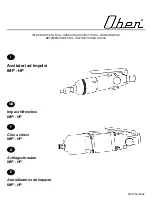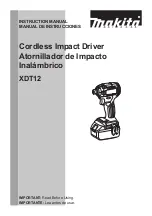
OPERATION
MANTENIMIENTO
SOLUCIÓN DE PROBLEMAS
Sistema de Protección de la Batería
Las luces LED no se iluminan en el cargador
La batería tiene un tiempo de duración corta
El gatillo de velocidad variable está bloqueado
El atornillador de impacto está dañando la cabeza del tornillo
El atornillador de impacto ha dejado de funcionar durante el uso
Chispas visibles a través de las aberturas de ventilación de la carcasa
Nota:
batería se reduce.
Si la herramienta se sobrecarga, suelte el interruptor de gatillo y elimine la causa de la sobrecarga. Presione el gatillo del interruptor
nuevamente para reiniciar.
impacto sobre el tornillo o la cabeza del perno. Disminuya la fuerza de velocidad soltando el gatillo interruptor.
La capacidad de la batería podría agotarse por completo. Coloque la batería en el cargador para recargarla.
la mano para continuar la operación.
Nota:
La capacidad indicada en la batería puede ser menor que el nivel real durante el uso o inmediatamente después de usar la herramienta.
This appliance should only be used by able-bodied individuals. Younger persons should only use the tool when supervised by a responsible
person who can ensure the tool is being used safely. Young children should not be allowed to use the tool - it is not a toy!
IMPACT DRIVER SAFETY WARNINGS
■
Wear ear protectors when drilling. Exposure to noise can cause hearing loss.
■
Use auxiliary handle(s), if supplied with the tool. Loss of control can cause personal injury.
■
Hold power tool by insulated gripping surfaces, when performing an operation where the cutting accessory may contact hidden wiring or its
own cord. Cutting accessory contacting a “live” wire may make exposed metal parts of the power tool “live” and could give the operator an
electric shock. Before drilling into walls, ceilings etc
,
ensure that there are no concealed power cables or pipes in the cavity.
WARNING! Some dust created by power sanding, sawing, grinding,
drilling and other construction activities contain chemicals known to
cause cancer, birth defects or other reproductive harm. Some exam-
ples of these chemicals are:
■
Lead from lead-based paints.
■
Crystalline silica from bricks and cement and other masonry products.
■
Arsenic and chromium from chemically treated timber.
Your risk from exposure to these chemicals varies, depending on how often you do this type of work. To reduce your exposure to these
chemicals: work in a well ventilated area and work with approved safety equipment, such as dust masks that are specially designed to filter
out microscopic particles.
GENERAL POWER TOOL SAFETY WARNINGS (CONT.)
Power tool use and care
■ Do not force the power tool. Use the correct power tool for your application.
The correct power tool will do a better and safer job when
used for its designed purpose.
■ Do not use the power tool if the on/o
ff switch is malfunctioning. Any power tool that cannot be controlled with the switch is dangerous and
must be repaired.
■ Disconnect the plug from the power source and/or the battery pack from the power tool before making any adjustments, changing
accessories, or storing power tools. This helps reduce the risk of starting the power tool accidentally.
■ Store idle power tools out of the reach of children. Do not allow persons unfamiliar with the power tool to operate it without first reading
these instructions. Power tools are dangerous in the hands of untrained users.
■ Properly maintain power tools. Check for misalignment or binding of moving parts, breakage of parts and any other condition that may
affect the power tool’s operation. If damaged, have the power tool repaired before use. Many accidents are caused by poorly maintained
power tools.
■ Keep cutting tools sharp and clean. Properly maintained cutting tools with sharp cutting edges are less likely to bind and are easier to
control.
■ Use the power tool, accessories, and tool bits, etc. by following these instructions, taking into account the working conditions and the work
to be performed. Use of the power tool for operations different from those intended could create a hazardous situation.
Service
■ Have your power tool serviced by a qualified repair person using only identical replacement parts.
This will ensure that the power tool is
properly and safely maintained.
■ If the supply cord is damaged, it must be replaced by the manufacturer
, its service agent or similarly qualified persons to prevent any
potential hazard.
WARNING! Read all safety warnings and instructions listed below.
Failure to follow the warnings and instructions may result in serious
injury.






























